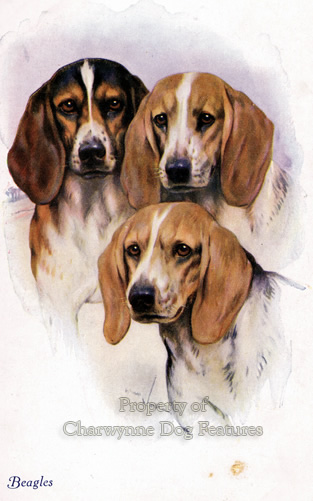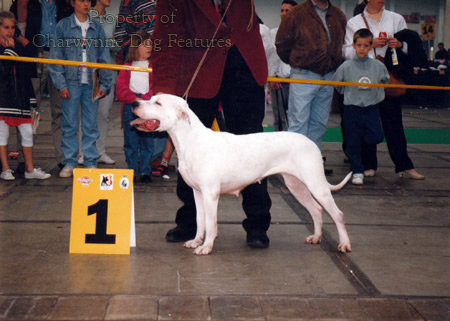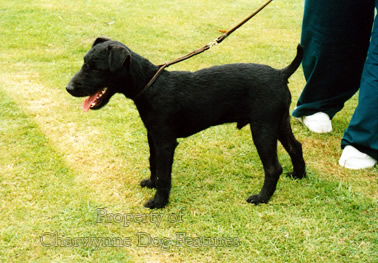326 BREEDING SOUNDER DOGS
BREEDING SOUNDER DOGS
by David Hancock
 In the United States, a number of scientific institutions are working hard to improve the genetic health of breeds of pure-bred dogs. The Institute of Genetic Disease Control in Animals at the School of Veterinary Medicine at the University of California and the School of Veterinary Medicine at Purdue University however both find that their biggest obstacle in research lies with breed clubs. Breed clubs simply will not provide honest reliable information to assist research, perhaps guarding their wallets more than their breed.
In the United States, a number of scientific institutions are working hard to improve the genetic health of breeds of pure-bred dogs. The Institute of Genetic Disease Control in Animals at the School of Veterinary Medicine at the University of California and the School of Veterinary Medicine at Purdue University however both find that their biggest obstacle in research lies with breed clubs. Breed clubs simply will not provide honest reliable information to assist research, perhaps guarding their wallets more than their breed. 
In Britain there are 45 breeds listed under the Kennel Club's Inherited Eye Diseases for Certification and another 45 under investigation. There are 12 breeds liable to selected inherited nutritional metabolism disorders, like copper storage disease in Bedlington Terriers. There are 10 breeds listed 'at risk' from elbow dysplasia. There are 8 breeds known to have carriers of primary epilepsy. Over 12 breeds feature Progressive Retinal Atrophy (PRA) and it has been reported in another 70 breeds. Lens Luxation has been seen in 8 terrier breeds. Incidences of dilated cardiomyopathy have occurred in 16 breeds.
Hereditary congenital deafness now occurs in half a dozen breeds. No less than 37 different Kennel Club recognised breeds are afflicted with hereditary deafness; there is no scheme to assess, record or reduce its incidence. The Kennel Club health scheme involves 25,000 dogs a year, but another 230,000 dogs are registered each year. The situation is getting out of control. Two years ago I proposed a health scheme for a breed I am involved in; it was defeated in a vote at the subsequent AGM. Who is going to grip this situation? Most breeds of pure-bred dogs come from a small gene pool. In over-popular breeds hasty money-chasing breeding, from flawed stock, is causing needless grief to hundreds of pet owners. And does any sportsman want a working dog that costs a fortune at the vets and dies young? 
Scientists know that inbreeding is often accompanied by an increase in defects: smaller litter sizes, increased post-natal mortality, reduction in body size, lower reproductive performance, less robustness and behavioural problems. It is not inbreeding per se which brings about these defects but the presence of deleterious recessive genes carried in the stock. Experience alone will not locate the presence of such genes, knowledge or informed advice is needed too. Even very old breeds like the Saluki, the Pekingese, the Standard Poodle and the Basenji, which rarely express a severe genetic abnormality, can be afflicted by a new mutation.
In the 1940s, US veterinary surgeon Leon Whitney found better disease resistance in his crosses between two pedigree breeds. A study by Scott and Fuller in 1964 indicated that the high puppy mortality characteristic of matings within a breed was greatly reduced when two different breeds were crossed. A study by Rehfeld in 1970 showed that the frequency of neonatal death in pure-bred Beagles increased with the degree of inbreeding. Ten years ago, a study by four distinguished Ontario Veterinary College scientists concluded that "The advantages of hybrid vigour in a pure-bred line could be realised in a carefully controlled breeding programme making use of out-crosses." Who is paying attention to such advice in pure-bred dogs? 
Heterosis, or hybrid vigour, in livestock breeding, is usually demonstrated by increase in size, enhanced live-weight gains, earlier attainment of maturity and increased disease resistance in the first generation of crosses. The offspring of these hybrids however do not automatically demonstrate this vigour to the same extent. This means that after an outcross, the gene pool needs to be stabilised again, especially in the protection of breed type. Is not the pursuit of a more robust breed worth a temporary risk to breed type? The really skilful breeders can obtain health, vigour and essential type. But in pedigree dogs, breed clubs usually ban outcrosses and KC support couldn't be guaranteed.
Yet all over Britain, away from Kennel Club rules, better motivated fanciers are at work, producing typy healthier dogs. I enjoy lurcher shows where the dogs on show are bred for functional performance not appearance. I attend working terrier shows where the dogs' ability to function is prized more than their looks. Three years ago, I judged the annual show of the Lucas Terrier Club and found an encouragingly lively bunch of feisty little dogs and likeable owners. There was no lack of vigour in this resurrected unregistered breed. A year ago I judged that much-maligned breed, the American Bulldog, unregistered in this country, and admired the sheer power of many of the entries. In mid-2000 I judged the Best in Show at the first annual show of the Victorian Bulldog Society and, shortly after, judged the first annual show of the newly-formed Sporting Lucas Terrier Club.
The Victorian Bulldog Society, under the leadership of Ken Mollett, is striving to produce a healthier dog in the mould of the pre-Pug cross dogs of the middle of the 19th century. From what I saw they have the genetic base for success and deserve our support. In Australia, Pip Nobes is doing similar work, as for some time has David Leavitt in the USA and Lolly Wilkinson in Canada. Ken and Elaine Mollett brought their 11 year-old bitch to the show. So many of the KC-registered Bulldogs die young. Longevity is surely something we desire in all our breeds and a feature we should actively seek.
The Sporting Lucas Terrier Club show, at Hope Hall, Bramham, was held alongside The Yorkshire Bedlington Terrier Club show. It was a hugely enjoyable occasion: two rings featuring alert red-blooded dogs and enthusiastic exhibitors more interested in owning healthy vigorous terriers than building a show career. There were black Bedlingtons there, a colour not seen at KC-licensed shows. The great setter man Laverack believed that a change of colour was as good as a change of blood. It was interesting to note that the dogs at the 1997 Lucas Terrier Club show were nearly all coloured, rather like their Norfolk Terrier cousins. The dogs at the Sporting Lucas Terrier Club show however were mainly white.
For any breed to favour a colour to the detriment of others can limit the genetic base of the breed. In a number of breeds of course the coat colour is the breed. But where a breed starts off with a variety of colours and then ends up favouring only one or two is an enormous loss. The Sporting Lucas Terrier Club committee is open-minded about colour and about an outcross. They discussed the merits of Jack Russell and Sealyham blood but may opt for an infusion of Norfolk Terrier blood. This would give them coloured dogs and reinforcement from an ancestor breed. Lord Lucas attended their show; his ancestor Sir Jocelyn Lucas, the creator of the breed, would have approved this course of action.
Distinguished breeders like Brough in Bloodhounds, Millais in Basset Hounds, Graham in Irish Wolfhounds, the Martinez brothers in Dogos Argentino, Laverack in English Setters and Edwardes in Sealyham Terriers had the skill and the vision to employ outside blood. Few pedigree breeds today were evolved without a combination of blood from identified breed-types. The emergent working terrier, the Plummer Terrier, comes from a blend of breeds utilised by a gifted breeder and now breeds true to type, with noticeable vigour. Unrecognised terrier breeds like the Patterdale may not boast of written pedigrees but they live long active lives and cost little at the vets.
Animal welfare and breed custodianship can never afford to be relegated to reacting only when things have gone too far; sickly breeds need to be identified and remedial measures coordinated and then implemented. Fostering the better health of a breed may not win rosettes or bring prestigeous judging appointments but from those claiming to love their breed it should attract the highest priority. Indirect cruelty to dogs is less easily spotted but is it not still a form of cruelty to knowingly breed from sickly stock or perpetuate a breed which has a short life-span and low disease resistance?
A slavish adherence to pure-breeding in dogs was very much a feature of 20th century society. But do we love breed type more than healthy active long-lived dogs? No working shepherd, professional terrierman, huntsman, cattle rancher or shooting man of the 19th century would have tolerated weedy dogs. That is how the splendid breeds we enjoy today came down to us. We insult the memory and betray the work of all those pioneer-breeders who bequeathed such dogs to us when we put breed purity ahead of breed vigour and breed robustness. Out-crossing, or cross-breeding, is no magic answer but it was the resort of many extremely knowledgeable truly experienced breeders in times past. It should not be unthinkable today.
The domestic dog is a subject creature; man's whim decides dog's fate. We are guilty of perpetuating breeds which, because 'worship of the pedigree' has been allowed to prevail, lack robustness, vigour and a healthy genotype. Worship of the phenotype, or what the dog looks like, ahead of all ethical factors, has led to breeds becoming prettier but no longer hale and hearty. Short-lived dogs may make dog-traders richer, (replacement pets are needed more regularly), but their premature deaths do not exactly enrich the allegedly valued man-dog relationship. Pet cemeteries should be full of old dogs not young ones. We rightly condemn puppy farmers on grounds of too much quantity. We should now look hard too at puppy-producers, calling themselves breeders, purely on grounds of quality -- the quality of the lives of the dogs they breed. 
Breeders when I was young favoured an expression which had long-term sense: never let the pedigree wag the dog. In these times the uncaring unintelligent but uniform perpetuation of pedigree breeds, whatever their genetic health, is a triumph of dogma over dog care. Pure-breeding has merit when things are going well but is disastrous when things are going wrong. Dogs which go blind, are born deaf or become crippled with hip dysplasia demonstrate how blind, deaf and morally crippled many breeders of pure-bred dogs have become. We get angry when we come across direct cruelty; indirect cruelty can cause just as much suffering. It's about time we got angry about flawed breeds and stopped valuing a piece of paper, a written pedigree, more than a healthy happy long-lived pet.